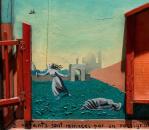Brooklyn Artist Keith Pavia Breaks Through the Boundaries of ‘Outsider Art’

As the art market grows and in turn splinters into a plurality of labels, styles, and movements, artists are faced with a decision – is it better to adhere to definition and face certain limitations in the public reception of their work, or shirk association and push forward into new and possibly little understood territory?
Brooklyn-based artist, Keith Pavia has wrestled with this dilemma of late, as he attempts to break through the boundaries of Outsider Art, a label that has undoubtedly helped foster his career, but one that has become somewhat restrictive as his work has matured.
Traditionally, the term Outsider Art was used as a marketing catchall phrase that included Folk Art, Art Brut, Visionary Art and any other art created outside of the boundaries of mainstream society. However, with the recent establishment of the annual Outsider Art Fair, as well as several galleries dedicated to the genre, professionals have seen exponential spikes in sales and critical recognition while artists are growing to become more market-savvy and knowledgeable of art world undertakings. As a result, Outsider artists are looking to branch out to more mainstream commercialized endeavors. Pavia seems intent on doing just that.
Pavia began to cultivate a name for himself through working closely with Fountain Gallery, a nonprofit venue in New York City representing artists with mental illness. Utilizing the gallery’s established network of curators and cultural institutions, he landed several important solo and group exhibitions and has frequently been featured at the annual Outsider Art Fair in New York City.

While his art lacks any product-oriented consistency, all of his pieces are homogenous in depicting whimsical fantasy worlds that marry melancholia and hope, the erratic with the uniform. His enigmatic work is bold in color and form, often figurative, yet lacks any association with the everyday world we live in. Allegorical characters and corporal archetypes are placed in constructed settings that leave the viewer contemplating a fabricated narrative and the bizarre substructure of human existence.
Pavia inherently denounces any mainstream agenda in his art. Instead, he chooses to look at art as more of a science shying away from uniformity and instead immersing himself in disparate artistic endeavors. This inconsistent creative approach has led to much admiration and respect within the art world.
Despite Pavia’s personal success as an Outsider, he prefers not to be weighed down by the term. As Pavia puts it, “I identify with a lot of the work that comes out of the ‘Outsider world.’ But the labels are trouble. I fall in to them all the time because it is the only way for me to define my extremism. There is no other way to do it. So, for the sake of the verbal I can be called an Outsider, but I don’t particularly like to be saddled the term. I’ve done a lot of work to make sure that I’m not.”

Through the creation of two artist collaboratives – Dust and Kimonophilia, with fellow artists Alex Roediger and Beatrice Schleyer – Pavia has allowed himself an outlet to express some of the more contemporary ideas he is looking to explore.
Dust, started several years ago by Pavia and Roediger, utilizes different mediums such as painting, collage and printmaking to marry impromptu, cartoon-like drawings and absurdist text into large-scale paintings and refined drawings.
The collaborative has grown in popularity with two past Brooklyn-based shows and a tentative exhibition later this year. Their work focuses on the notion of an economic, production-oriented society with a goal of bringing low art in to the highbrow realm. For their first show, Pavia and Roediger created giant murals featuring giant, unembellished cartoons directly on walls. Additionally, they created books, magazines, and any other object to put their images on, playing on the idea of selling out.

Beyond being an escape mechanism from the Outsider Art world, Dust allows Pavia to explore other creative processes other than his signature organic method. Procedurally, the artists work out paintings by doing sketches together. Then, it is Roediger who works out any color separations on the drawings then hands it off to Pavia to complete the paintings. This manner of progression allows Pavia to remove himself from the raw emotionalism he is known for and rids the work of the psychological weight Outsider Art carries.
In addition to Dust, Kimonophilia, an artistic collaborative with heavy Japanese influences, has allowed Pavia to explore other realms of the art world. Alongside photographer Beatrice Shindler, the artists have created both a blog and a series of portraits exploring the pattern, rhythm and shapes of Japanese textiles. Moreover, the work places an importance on the idea of spatial flatness and visual texture. Although still in its beginning stages, Kimonophilia has already shown great success with several pieces mounted at a recent exhibition at Fountain Gallery and an upcoming show this November.
Pavia readily admits his work has changed radically since he began working in collaboratives. He enthusiastically remarks, “It works for me. In some ways I almost get another side of the brain. That’s usually the kind of person I’m attracted to working with. Someone who can fulfill that.” As for embracing the commercial art world, Pavia believes working in a collaborative is the most logical strategy for an Outsider to move into the mainstream realm. “There is a certain pressure that gets taken off of your back,” he explains. “The great thing about working with another person is that some of that stress gets relieved. I don’t know if I want to take that kind of load on alone.”
Without a doubt, Pavia walks the line between mainstream and Outsider status and feels comfortable doing so. Despite balancing an extremely dynamic career, Pavia does not seem concerned about where the future will lead him. When asked what he has planned next, he simply answers, “Art is an adventure, an expedition. Who doesn’t want to be on an adventure? It makes life interesting.” Whether working alone, collaboratively, as an Outsider or not, one thing is certain: Pavia’s career will unquestionably continue to progress on his own terms and time, not anyone else’s.
Author Bio:
Kristin Sancken is a contributing writer at Highbrow Magazine.





























































































































































































































































































































